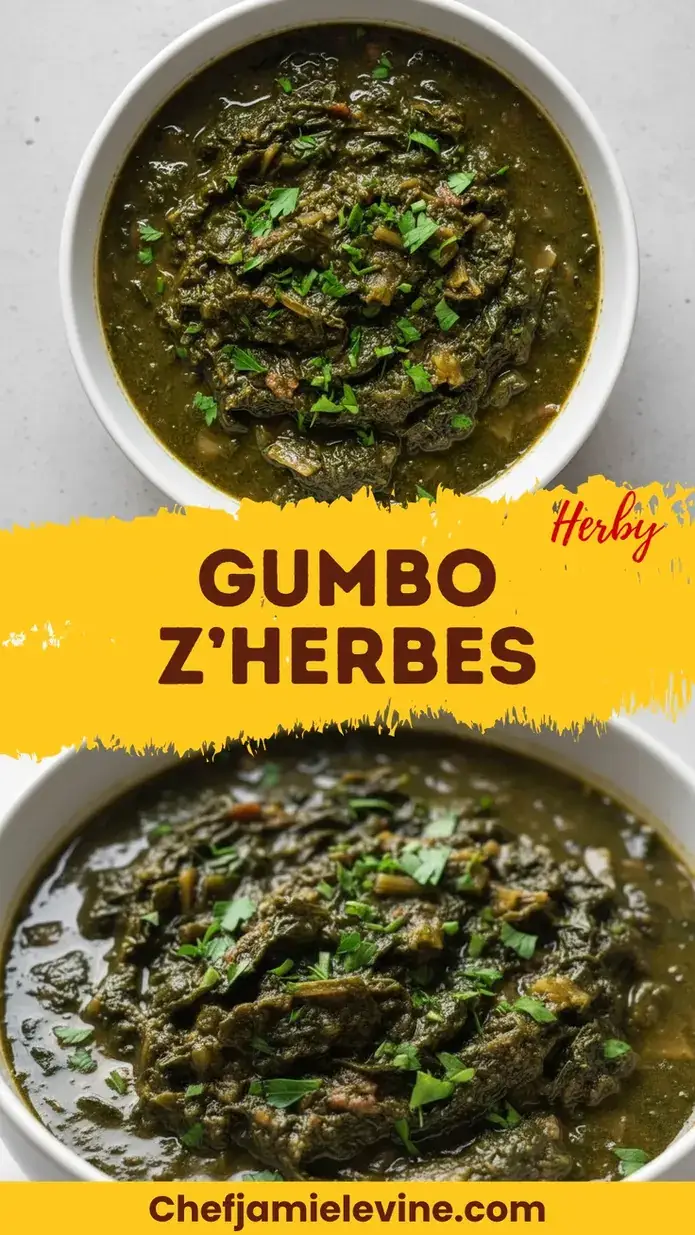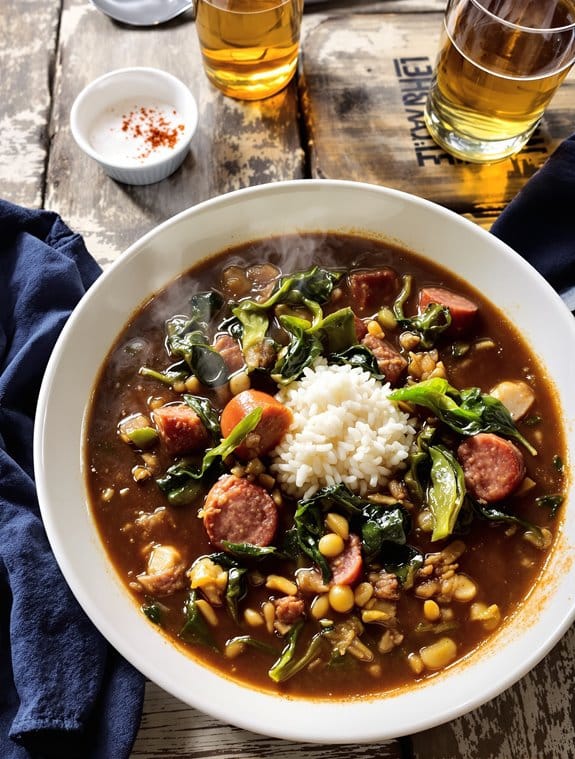Why You’ll Love this Gumbo Z’Herbes
If you’re looking for a dish that perfectly balances tradition with incredible flavor, this Gumbo Z’Herbes is about to become your new favorite. I love how this recipe transforms simple greens into something magical through that slow-cooked roux.
The combination of mixed greens with smoky ham and garlicky sausage creates layers of flavor you simply can’t find in other dishes. And isn’t there something satisfying about turning humble ingredients into a meal that warms the soul? Plus, it’s versatile—use whatever greens you have on hand. The deep, rich broth developing over those two hours of simmering? Worth every minute.
What Ingredients are in Gumbo Z’Herbes?
The heart of any good Gumbo Z’Herbes lies in its diverse blend of greens and that perfect roux that gives the dish its distinctive character. This traditional Louisiana dish (sometimes called “green gumbo”) combines a variety of leafy vegetables with smoky meats and a carefully developed roux base.
The ingredient list might seem lengthy at first glance, but each component plays an essential role in building those complex flavors that make this dish so beloved in Creole and Cajun cuisine.
- 2 pounds mixed greens (collard greens, mustard greens, turnip greens, beet tops, carrot tops, radish tops, spinach, etc.)
- 1/4 cup bacon fat or corn oil
- 1/3 cup all-purpose flour
- 1 large onion, peeled and chopped
- 1 clove garlic, peeled and minced
- 1 green pepper, cored, seeded and diced
- 1 bay leaf
- 1/2 teaspoon dried thyme
- 1-1 1/2 teaspoons salt
- 1/4 teaspoon black pepper
- 1/4 teaspoon white pepper
- 1/4-1/2 teaspoon cayenne pepper
- 1/2 pound smoked ham, cut into chunks
- 1/2 pound garlic sausage or andouille sausage, cut into chunks
When selecting your greens, remember that variety really matters here. Traditional gumbo z’herbes often incorporates an odd number of greens (sometimes seven, nine, or eleven types) which some say brings good luck.
Don’t worry if you can’t find every type listed—use what’s fresh and available to you. The meats can also be adjusted based on preference; while andouille offers authentic flavor, any smoked sausage will work in a pinch.
And that bacon fat? It’s worth using if you have it, as it adds a depth of flavor that’s hard to match with regular oil, though the corn oil makes a perfectly acceptable substitute.
How to Make this Gumbo Z’Herbes

Making gumbo z’herbes begins with proper preparation of your greens. Start by thoroughly washing all 2 pounds of your mixed greens—collards, mustard greens, spinach, whatever combination you’ve chosen. Give them a good rinse, because nobody wants gritty gumbo. Chop them coarsely, removing any tough stems, then cook them in a large kettle with 1 cup of cold water until they’re nicely wilted, which takes anywhere from 5 to 15 minutes depending on which greens you’re using.
Once wilted, drain them but save that precious cooking liquid. You’ll need to add enough water to that reserved liquid to make 1½ quarts total.
Now comes the most essential part—making the roux. In a heavy pot, heat ¼ cup of bacon fat (or corn oil if you must), then gradually add ⅓ cup all-purpose flour, stirring constantly for about 15 to 20 minutes until it reaches that perfect peanut butter color.
Patience is everything here; a rushed roux is a ruined roux. Once your roux hits that ideal medium brown, add 1 large chopped onion, 1 minced garlic clove, and 1 diced green pepper, cooking until they soften, about 5 to 10 minutes. This aromatic base is what builds the foundation of your gumbo’s flavor.
The final assembly brings everything together. Stir your measured liquid into the roux mixture, along with 1 bay leaf, ½ teaspoon dried thyme, 1 to 1½ teaspoons salt, and your trio of peppers (¼ teaspoon each of black and white pepper, plus ¼ to ½ teaspoon cayenne for heat).
Add your cooked greens, ½ pound of chunked smoked ham, and ½ pound of chunked garlic or andouille sausage. Let this magnificent pot simmer for 1½ to 2 hours, stirring occasionally as the flavors meld and deepen.
Before serving over rice, don’t forget to fish out that bay leaf and adjust the seasoning to your liking. What emerges is a rich, complex gumbo that honors its Louisiana roots—hearty, herbaceous, and utterly satisfying.
Gumbo Z’Herbes Substitutions and Variations
While traditional gumbo z’herbes calls for specific ingredients, you’ll find endless possibilities for customization based on what’s available in your kitchen or at your local market. I often swap collards for kale when my garden’s overflowing, or use vegetable oil instead of bacon fat for my vegetarian friends.
Don’t have andouille? Regular smoked sausage works in a pinch. The real magic happens with the greens—the more varieties, the merrier. Seven different greens are considered lucky in Creole tradition. And that roux? Medium brown like peanut butter gives the perfect flavor foundation, but you can go darker if you’re feeling adventurous.
What to Serve with Gumbo Z’Herbes
So what completes a steaming bowl of gumbo z’herbes at your dinner table?
The classic pairing is a scoop of fluffy white rice, which soaks up all that rich, herbaceous broth beautifully.
I like to serve mine with warm cornbread, its slightly sweet crumb offering the perfect contrast to the spicy, savory gumbo. A simple side salad with a vinaigrette dressing adds brightness, or try some pickled vegetables for a tangy counterpoint.
Cold beer works wonderfully here, though sweet tea is my go-to when serving this to my Sunday dinner crowd.
Final Thoughts
After experiencing the rich traditions of gumbo z’herbes firsthand, I’ve come to appreciate why this dish holds such a special place in Louisiana cuisine.
It’s more than just a meal—it’s a celebration of abundance, resourcefulness, and cultural heritage.
What I love most about this recipe is its adaptability.
Don’t have all seven greens? No worries, use what you can find.
The soul of the dish remains intact.

Traditional Gumbo Z’Herbes
Ingredients
Equipment
Method
- Thoroughly wash all mixed greens, removing any tough stems. Coarsely chop the greens.
- Place the chopped greens in a large pot with 1 cup of cold water. Cook until wilted, about 5-15 minutes depending on the types of greens used.
- Drain the greens but reserve the cooking liquid. Add enough water to the reserved liquid to make 1½ quarts total.
- In a heavy-bottomed Dutch oven, heat the bacon fat or corn oil over medium heat. Gradually add the flour, stirring constantly with a wooden spoon for 15-20 minutes until the roux reaches a medium brown color similar to peanut butter.
- Add the chopped onion, minced garlic, and diced green pepper to the roux. Cook until vegetables are softened, about 5-10 minutes.
- Slowly stir the reserved liquid into the roux mixture, ensuring no lumps form.
- Add the bay leaf, dried thyme, salt, black pepper, white pepper, and cayenne pepper.
- Stir in the cooked greens, smoked ham chunks, and sausage pieces.
- Bring the mixture to a gentle simmer, then reduce heat to low. Cover partially and simmer for 1½ to 2 hours, stirring occasionally as the flavors develop and meld together.
- Remove the bay leaf before serving. Taste and adjust seasonings if needed.
- Serve hot over white rice.



